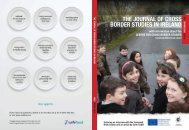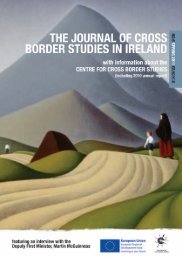improving government service delivery to minority ethnic ... - NCCRI
improving government service delivery to minority ethnic ... - NCCRI
improving government service delivery to minority ethnic ... - NCCRI
Create successful ePaper yourself
Turn your PDF publications into a flip-book with our unique Google optimized e-Paper software.
It is important that training on <strong>service</strong> provision <strong>to</strong> <strong>minority</strong> <strong>ethnic</strong> groups explains the importance of data<br />
collection. There are examples in this report that could be used <strong>to</strong> explain effective use of data, such as the<br />
Central Scotland Police initiative ‘Safer Businesses for Ethnic Minorities’ in which statistics indicated that over<br />
60 per cent of racist incidents occurred within business premises owned/managed by members of <strong>ethnic</strong><br />
<strong>minority</strong> communities and so a project was set up <strong>to</strong> address the issue.<br />
252_Caroline Coleman,<br />
South Tyrone Empowerment<br />
Programme (STEP),<br />
speaking at the conference.<br />
Data can be gathered from a number of sources, and it is important that complementary data sources are<br />
used. For example, Census data in Northern Ireland is widely acknowledged <strong>to</strong> be out of date and provides<br />
inadequate differentiation of <strong>ethnic</strong>ity vis-à-vis the actual <strong>ethnic</strong> make-up of the jurisdiction; or in the Republic<br />
of Ireland data on PPSN provides only flows of workers from the EU, including EU Accession States and<br />
does not represent the actual number of workers in the country. Quantitative and qualitative research may also<br />
be required <strong>to</strong> provide an accurate profile of <strong>service</strong> users and potential <strong>service</strong> users. As described above,<br />
traditional quantitative research may not in itself be adequate in planning <strong>service</strong> <strong>delivery</strong> for <strong>minority</strong> <strong>ethnic</strong><br />
groups. One panellist’s view at the conference in response <strong>to</strong> a question on data collection was:<br />
“ I work with what is probably a very highly nomadic community [migrant workers] as<br />
are some are the Traveller organisations that are here. One size doesn’t fit all. The kind<br />
of data that we use <strong>to</strong> provide <strong>service</strong>s for the majority of the community does not<br />
necessarily work for the <strong>minority</strong> community. I would prefer <strong>to</strong> see qualitative information,<br />
really good examples of good models…” 252<br />
This is indicative of the fact that traditional data collection mechanisms in Northern Ireland have not served the<br />
migrant worker population well and <strong>service</strong> providers are struggling <strong>to</strong> deal with this. Data collection based on a<br />
variety of sources will help with <strong>service</strong> <strong>delivery</strong> planning, including target setting, and resource planning and will<br />
be useful for benchmarking against the targets set. The table below describes the data collection process, uses<br />
and sources.<br />
Table 12: Data Collection<br />
Ascertain: Purpose Data source<br />
1 Who is currently using the<br />
<strong>service</strong><br />
2 Who is not currently using the<br />
<strong>service</strong><br />
3 What the outcomes are for the<br />
client groups<br />
Clients <strong>to</strong> be engaged in<br />
relation <strong>to</strong> planning and<br />
evaluating <strong>service</strong> provision.<br />
Need <strong>to</strong> engage and ascertain<br />
why they are not accessing<br />
the <strong>service</strong> (e.g. systemic<br />
barriers).<br />
Establishing trends in <strong>minority</strong><br />
<strong>ethnic</strong> groups in relation<br />
<strong>to</strong> outcomes (e.g. socioeconomic<br />
indica<strong>to</strong>rs).<br />
Internal data collated by the<br />
organisation.<br />
External data (e.g. Census –<br />
if accurate), cross-referenced<br />
with internal data (from no.1<br />
above).<br />
Internal and external data<br />
sources (e.g. examination<br />
results within a school as an<br />
internal data source).<br />
What has emerged from the research is that some current data collection is inadequate, missing, inaccurate or<br />
piecemeal. Ideally <strong>service</strong> providers in each jurisdiction would develop standard data collection categories or<br />
‘fields’ for forms, databases and reporting. Also, for the purposes of cross-border co-operation and comparability,
















